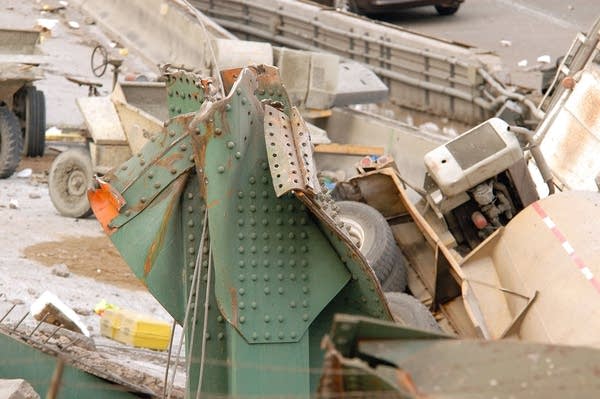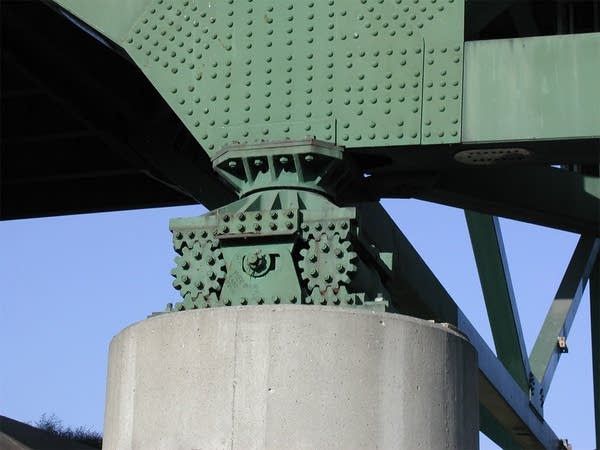Attorney: NTSB is wrong about cause of bridge collapse
Go Deeper.
Create an account or log in to save stories.
Like this?
Thanks for liking this story! We have added it to a list of your favorite stories.

A consortium of lawyers hired the international consulting firm Thorton Tomasetti to investigate the collapse. The firm also investigated the collapse of the World Trade Center.
Lawyer Chris Messerly of Robins, Kaplan, Miller & Ciresi represents the consortium. He said that engineers concluded that the starting point for the collapse was not a faulty gusset plate, as the NTSB found, but a horizontal steel beam called a chord.

Construction materials on the bridge at the time of the collapse put too much stress on the bridge, he said. Messerly said the bridge's roller bearings were frozen, so it couldn't shift to relieve the stress.
"That was well known by the consulting agency hired by the state, and because the bridge would not expand and move with the heat, it caused this catastrophic failure," Messerly said.
Turn Up Your Support
MPR News helps you turn down the noise and build shared understanding. Turn up your support for this public resource and keep trusted journalism accessible to all.
Instead of shifting with the heat and weight, the beams took on the pressure, and eventually one of them, the "L9-L11 west," fractured.
"It's URS the consulting firm responsible for seeing all of this and its failure to take action; and PCI, who, rather than place its construction material a couple hundred feet off the bridge, placed them on the bridge, a weight amounting to a 747," he said.
Messerly said the report indicates that it was only after the beam fractured that the U10 gusset plate broke.
The NTSB concluded that the gusset plate failure led to the collapse. Investigators there found the U10 gusset plate was too thin due to a design flaw, and weight added over time and on the day of the collapse pushed the plate beyond capacity.
Messerly said the NTSB got some of the investigation right, but not all of it.
"This is the first time anyone has explained exactly why the bridge fell, and why it fell at that time."
"They never explained why it fell on that day, as compared to a day or a month or a year before or after August 1," he said. "And now we know why it happened on that day."
The NTSB declined to comment.
The engineers' conclusions give the attorneys legal grounds for suing two contractors that worked on the bridge before it collapsed Aug. 1. 2007, killing 13 people and injuring 145.
The bridge victim consortium is expected to file lawsuits against the consulting firm URS and the construction company PCI in the coming months.
They can't sue the state, which owned the bridge, because their clients gave up that right when they accepted compensation from a $36.4 million fund set up by the Legislature, though other victims have until April 16 to decide whether to take the state money.
Kyle Hart, an attorney for PCI, expressed skepticism about Thornton Tomasetti's conclusions.

"Obviously I'm interested in hearing anybody else's theories, but I would tend to doubt the validity of that one," Hart said.
Four other victims have already sued URS and PCI. PCI is seeking to add the state and Jacobs Engineering Group Inc., the successor company of the bridge's designer, as defendants in that lawsuit.
Messerly said they have photographic evidence that the state and URS knew the roller bearings where the bridge sat on its concrete supports were corroded and couldn't move.
Hart said PCI doesn't accept all the NTSB's findings, but that the company contends it's not at fault.
"It's not surprising that they're going to name everybody -- that's to be expected," Hart said. "But the key thing is nobody has demonstrated the amount of weight we had on the bridge was improper. ... If the bridge had not been improperly designed, everybody says it would have held up that weight easily."
For now, Messerly said, the survivors and attorneys are calling for a nationwide inspection of roller bearings on all similarly designed bridges, and that any roller bearings found to be frozen should be fixed.
About 140 bridge survivors and relatives packed a conference room to hear the engineers' presentation Tuesday night, Messerly said. Some wept, while others were relieved to hear "the whole truth as revealed by these experts," he said.





